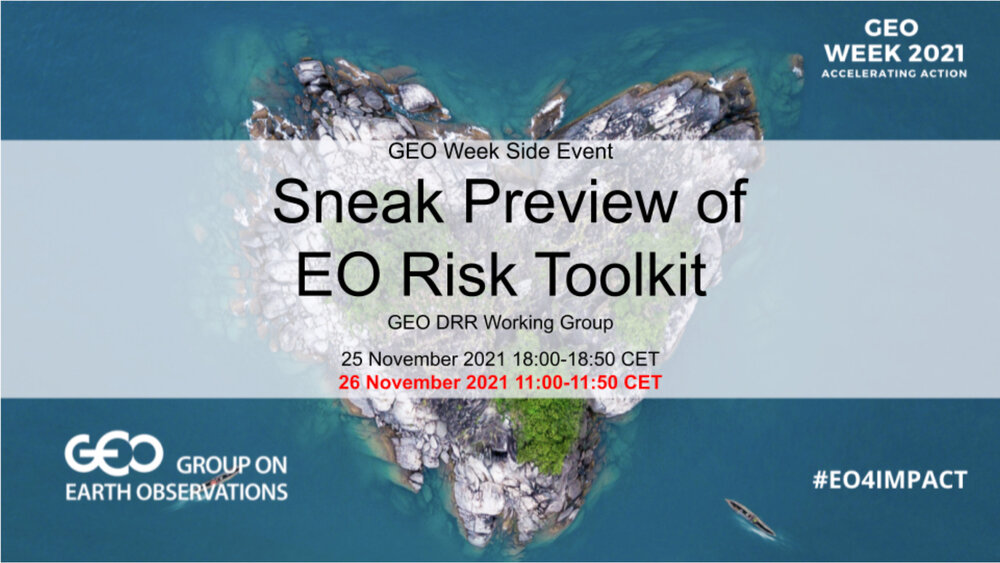Insights from the ‘Sneak Preview of EO Risk Toolkit’ side event GEO Week 2O21

The recently concluded GEO Week 2021, featured many of the activities of its work programme, which addresses nexus thinking in the use of Earth Observations (EO) for risk-informed development. Among the more than 60+ sessions that took place, the side event ‘Sneak Preview of EO Risk Toolkit’, organized by the GEO Disaster Risk Reduction (DRR) Working Group (WG) was notable. The EO Risk Toolkit, similar to the Sustainable Cities and Human Settlements Toolkit, is a planned hub site that will provide DRR users with access to open-source EO tools and services, as highlighted in this blog post. The toolkit is being developed in collaboration with the UNDRR flagship initiative Global Risk Assessment Framework (GRAF) and Esri.
As highlighted in the EO Risk toolkit concept note attached as Annex D (pp. 12-18) of the DRR WG report to the GEO Plenary, the development of the toolkit is motivated by the fact that more than 50% of the current 64 GEO Work Programme (GWP) activities support the implementation of the Sendai Framework for Disaster Risk Reduction. This strength, identified through the GWP mapping can be leveraged to engage the GEO community in strengthening the science-policy interface in disaster risk reduction and ultimately inform sustainable development.
The key points from the side event presentations are that the DRR ‘users’ for whom the EO Risk Toolkit would be most useful are people working in national and local disaster management authorities, development, humanitarian actors and National Sendai Focal Persons. This is because the toolkit would provide them with granular risk information across disciplines to address the increasingly interconnected systemic nature of climate exacerbated risks. This EO Risk Toolkit would also be particularly useful for government decision makers, providing concise summaries of policy options for adopting EO tools and services that could reduce the risk of climate exacerbated disasters. Initially, the toolkit is likely to focus on the Least Developed Countries (LDCs) and Small Island Developing States (SIDS), including pilot countries from GRAF such as Fiji, Pakistan, Bangladesh, Eswatini, Sudan, South Sudan and Costa Rica.
The discussions that followed after the presentations highlighted opportunities for collaborations with GEO members. For example, the Human Planet Initiative (HPI), one of the activities of the GEO Work Programme, offered to provide its over 40 years of exposure data on settlement and populations to manage systemic risks. The UN World Food Programme, which is a GEO Participating Organization, is interested in joining forces with the GEO DRR-WG team by leveraging similar efforts called the Real-time Impact and Situation Monitoring (PRISM). GEO’s Pacific Island Advisory Group (PIAG) and the Digital Earth Pacific will partner with GEO DRR-WG to reach out to the Pacific Island countries.
Currently, GEO DRR WG is working directly with the UNDRR IT and ESRI teams to establish a framework for the Hub. In the middle of this process would be a co-design process with end-users of the EO Risk toolkit. Those identified as potential partners in the discussion session are likely to join the DRR-WG or the toolkits’ User Co-design Team which will be established in the coming months. The EO Risk Toolkit is scheduled for public launch in May 2022 at the Seventh Session of the Global Platform for Disaster Risk Reduction (GPDRR) scheduled to take place in Bali. We encourage you to watch the recorded Sneak Preview of the EO Risk Toolkit’ sessions at this link and let us know what you think or get in touch.